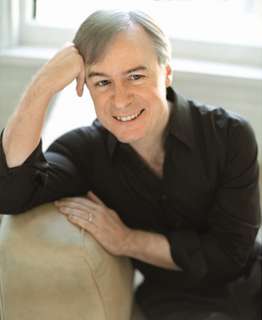|
Back
A Wealth of Miraculous Mandarins New York
Stern Auditorium, Carnegie Hall
11/04/2009 -
Igor Stravinsky: Le Chant du rossignol (Song of the Nightingale)
Tan Dun: Water Concerto
Bright Sheng: Colors of Crimson
Béla Bartók: The Miraculous Mandarin Suite
Colin Currie (Percussion)
St. Louis Symphony Orchestra, David Robertson (Music Director and Conductor)

D. Robertson (© David Robertson)
Stating that David Robertson is the most mesmerizing conductor in America today is stating the obvious. Others might disagree with this tempo or that coloration. But nobody can deny his Presence (with a capital P), his control of any orchestra (from his own Saint Louis to the more sedate NY Phil) to his almost inhuman energy.
It took all that energy to perform four exceptionally difficult works last night for the “Ancient Paths/Modern Voices” celebration of China at Carnegie Hall last night. Any single work would be the highlight of a concert, but one could equally look at them as an assemblage of exotic chinoiserie, David Robertson style.
Book-ending the concert were two exotic composers on their own. Stravinsky’s 1917 suite from a Chinese fairy tale, with instrumental hues which make Sacre sound like a Max Reger organ work. (Okay, an exaggeration.) Bartók’s Miraculous Mandarin suite speaks for itself as one of the primal post-Sacre ballets.
In the middle, China’s most brilliant composers produced works amongst their most interesting. Bright Sheng – finally coming into his own – had his marimba concerto, Colors of Crimson played by a crimson-shirted Colin Currie, while the same percussionist played (or shook or dunked or soaked) Tan Dun’s Concerto for Water.
The latter was visually more entrancing than its liquid tones. Two percussionists on either side of the orchestra were behind glass bowls filled with water and played with various instruments. Mr. Currie began by prancing down the aisle with a strange bronze-type cylinder (looking like a church censer) up to the stage for his own centrepiece of two glass bowls, each of them miked.
During the orchestral growls, tunes and both Western and Asian tunes, the water is slapped around by hand, or gongs are immersed and played and then struck or bowed, and more tubes, shakers, bottles and bells add to the auditorium interest. For the climax, Mr. Currie lifetd a large colander and the water cloursed down in a sparkly fountain.
Needless to say, such magical effects drew a standing ovation. If I didn’t stand, it was not out of lack of respect, but that the watery fireworks, played brilliantly, obviously notated with scruipulous care, doesn’t happen to be Mahler or Stravinsky, but a very clever party trick.
Bright Sheng, a composer I have admired the rare times I have heard him, is hardly as flashy, but his Concerto, based on a tune he wrote as a teenager, produced a work of utmost interest. The limited tones of the marimba were magnified in color by doublings with orchestral instruments, by canonic forms, by a constant interest in the legerdemain we expect from Mr. Currie. Where the Tan Dun work was joltingly good, Bright Sheng had a piece I would listen to again and again.
Mr. Robertson has an ensemble which doesn’t deserve to be in Saint Louis, but since that one-time metropolis has only a baseball team, a river and an orchestra (the Mississippi paddle boats stopped landing 150 years ago!), I guess they deserve it. Mr. Robertson deserves any orchestra. He drove the rhythms with utmost urgency in the Bartók, and the Stravinsky – all too rarely played, though one of the glistening works of the master – was an opening tour de force, and Mr. Robertson led the multi-rhythmic ersatz Chinese fairy tale suite like a demon magician.
Harry Rolnick
|